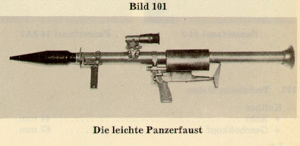PzF 44
| PzF 44 2A1 | |
|---|---|
|
PzF 44 | |
| Type | Anti-tank rocket launcher |
| Place of origin | West Germany |
| Service history | |
| In service | 1960s–1990s |
| Used by | Germany |
| Production history | |
| Manufacturer | Dynamit Nobel |
| Specifications | |
| Weight | 7.8 kg (17 lb 3 oz) |
| Length | 880.0 mm (2 ft 10.65 in) |
|
| |
| Caliber | 44 mm (1.7 in) barrel, 67 mm (2.6 in) warhead |
| Muzzle velocity |
168.0 m/s (551 ft/s) (muzzle) 210.0 m/s (689 ft/s) (max) |
| Maximum firing range | ~ 400 m (1,300 ft) |
| Sights | Telescope |
The PzF 44 2A1 (also called Lanze, Leichte Panzerfaust, or Panzerfaust 2) is a recoilless anti-tank weapon.
History
The anti-tank grenade launcher was originally developed around 1960 and put into service by the Bundeswehr shortly thereafter. It was developed to provide West German infantry with a modern replacement for the Bazooka that they had previously used. As such, it was the first German antitank rocket developed after World War II, a conflict in which German hand-held antitank weapons such as the Panzerfaust played a prominent role during 1944–45. The Lanze was a product of a period in which the German army was re-equipped with locally developed arms and equipment and retired the aging U.S. gear that had formed their initial arsenal. The full designation name by the German Army is Panzerfaust 44mm DM2 Ausführung 1 Lanze.
Specifications
The Lanze's 1.5 kg (3.3 lb) high explosive antitank (HEAT) DM-32 projectile could penetrate 370 mm (15 in) of rolled homogeneous armor and hit moving targets at a range of 300 m (980 ft). The Lanze could also fire a multi-purpose warhead. Starting in 1992, the PzF 44 was replaced by the Panzerfaust 3.
| Performance of PzF 44 and contemporary weapons | ||
| Effectiveness against rolled homogeneous armor | ||
| Weapon | Armor penetration in mm | Max range to hit a moving target in meters |
| PzF 44 | 370 | 300 |
| RPG-7V | 320 | 300 |
| M72 LAW | 305 | 150 |
| Data source for weapons performance is Jane's Infantry Weapons 1984-85. | ||
